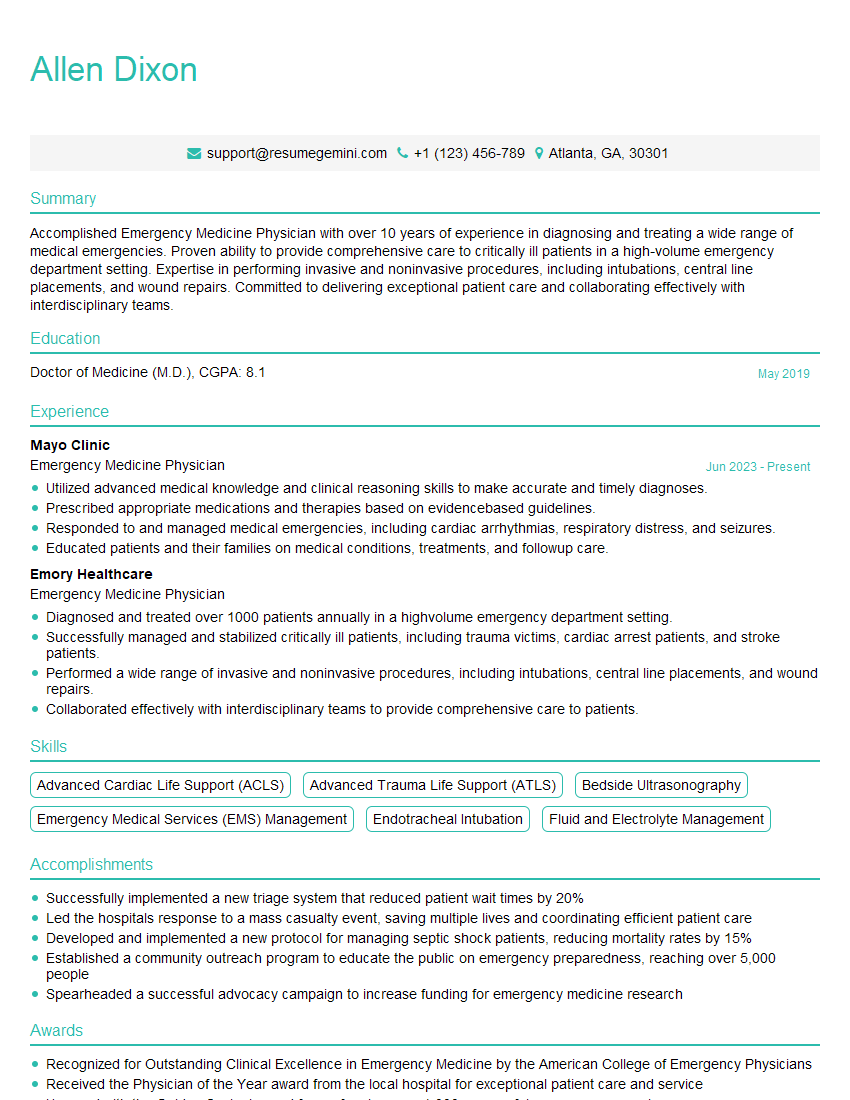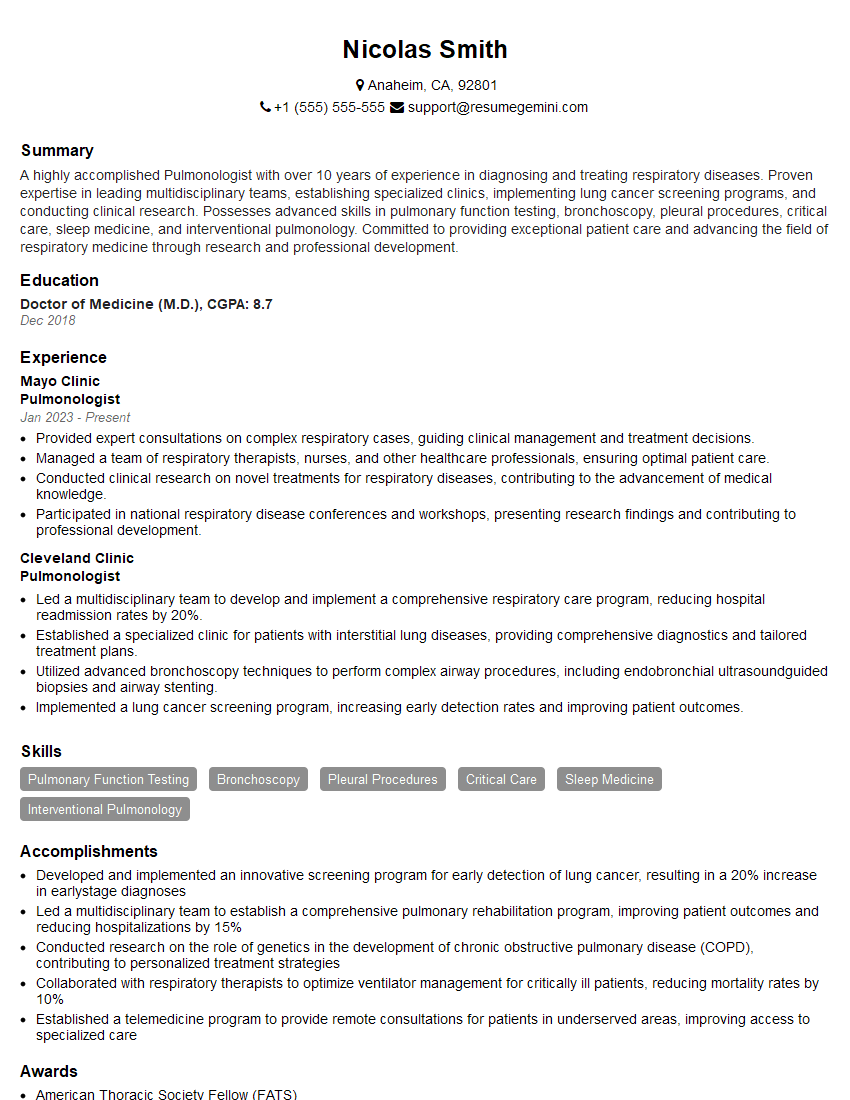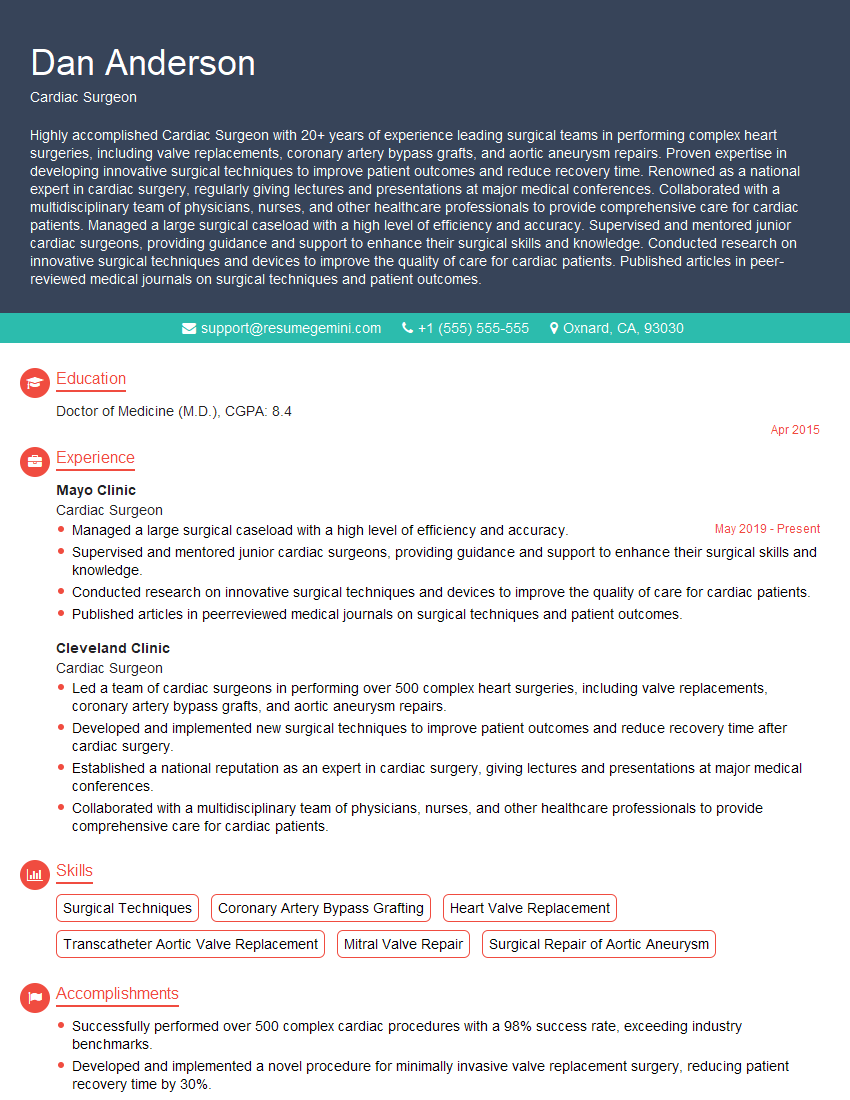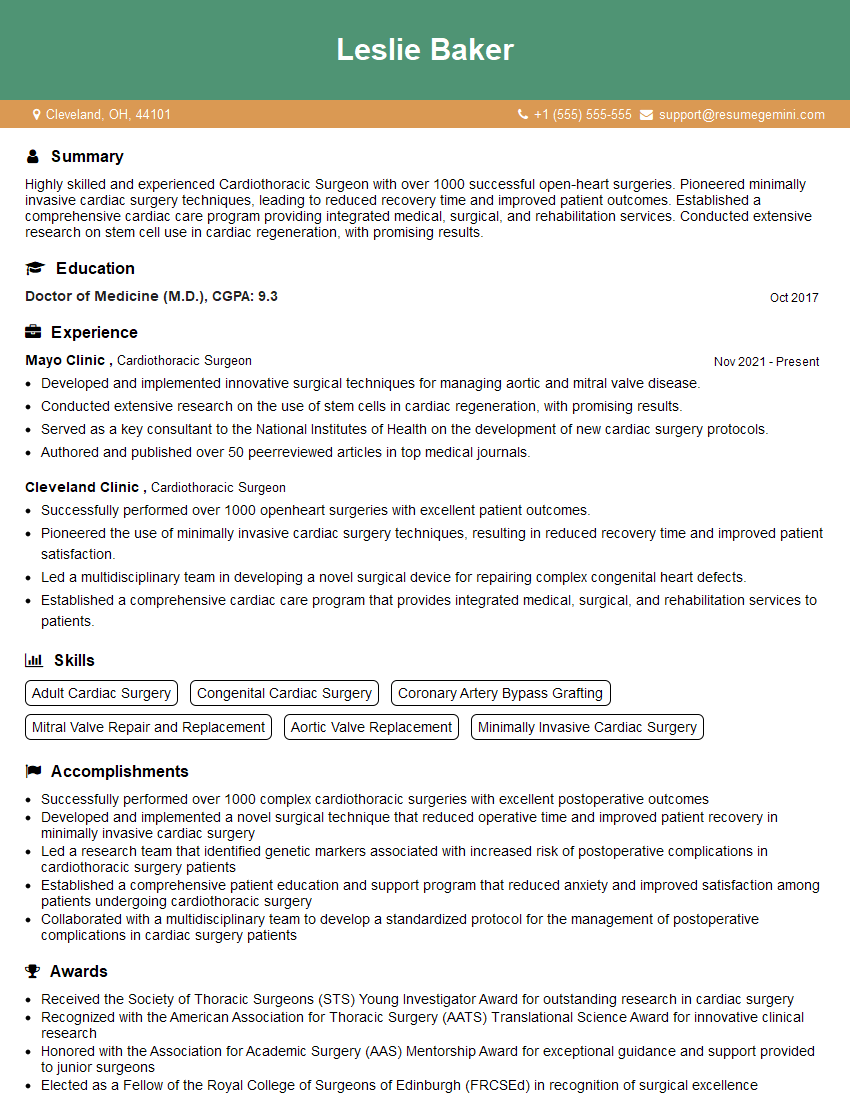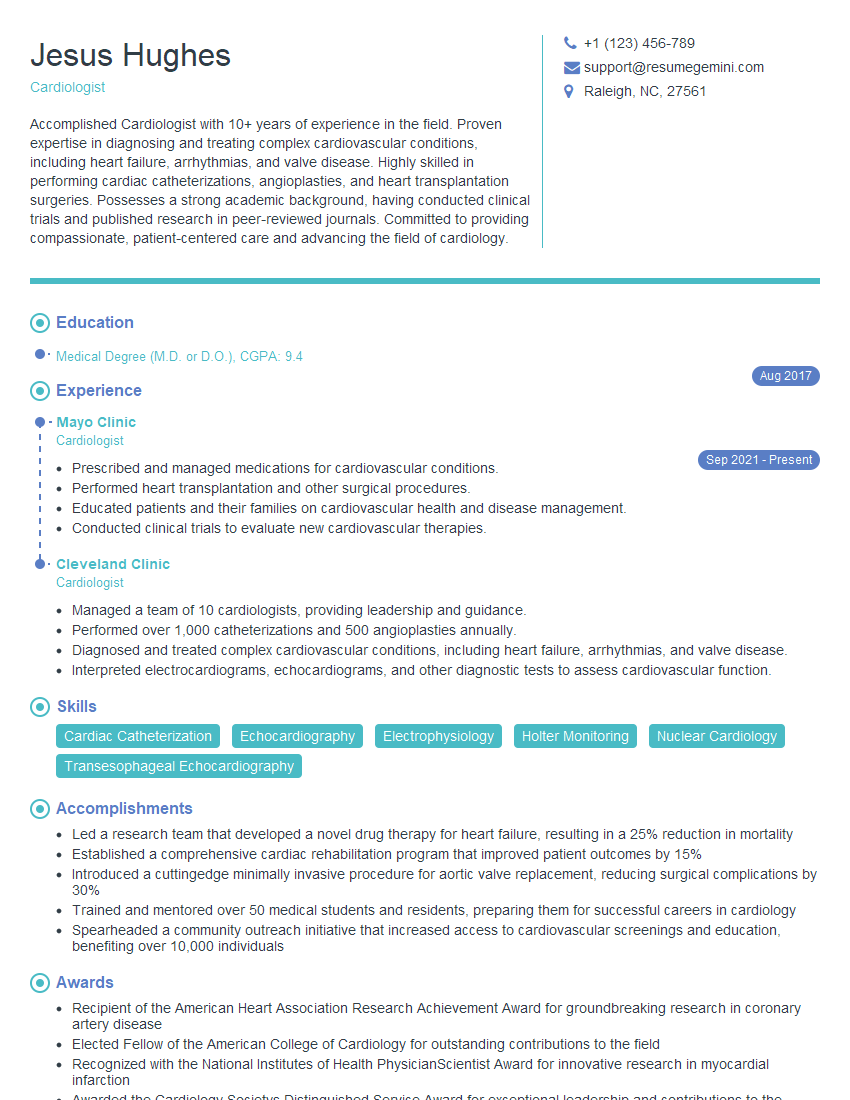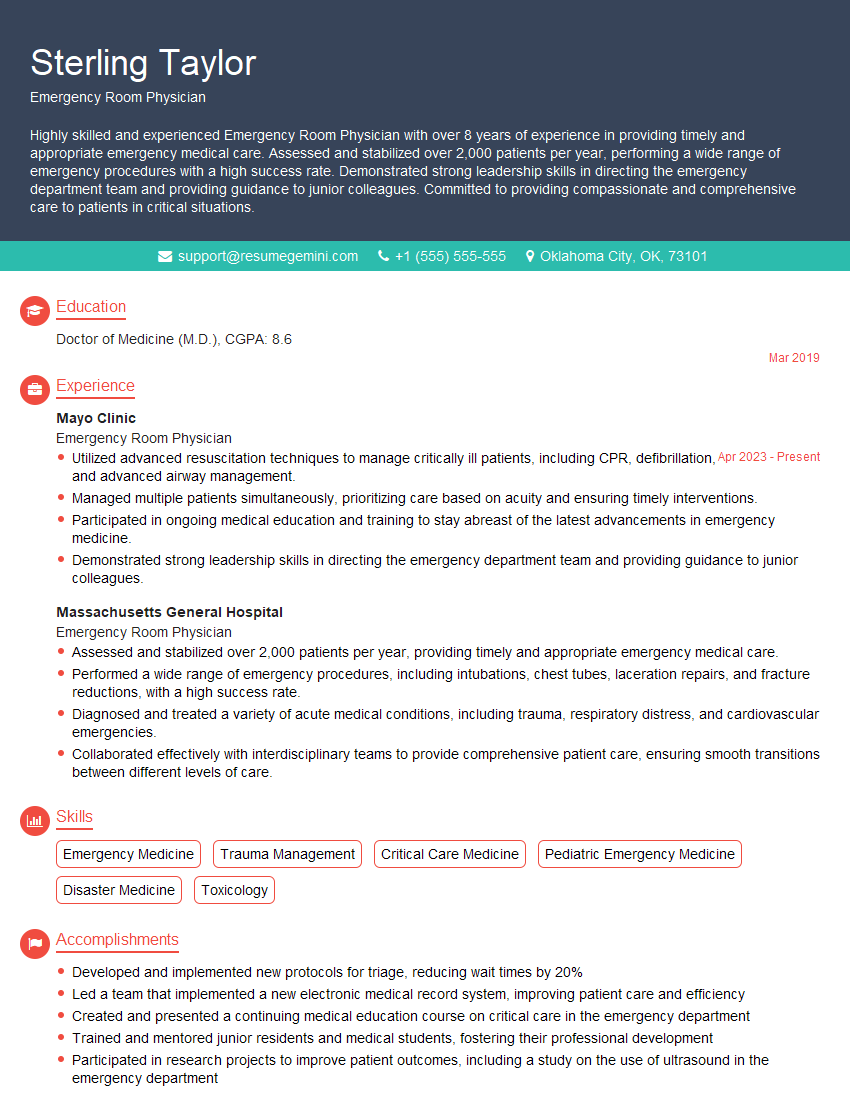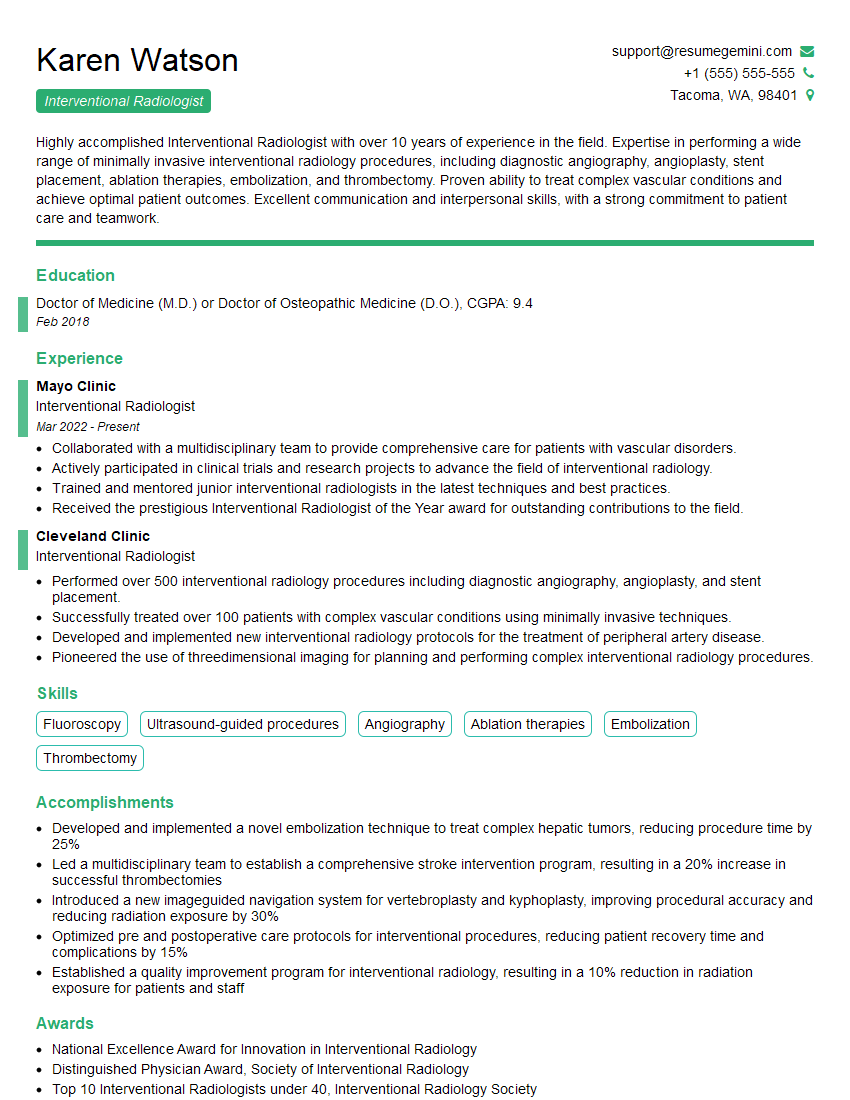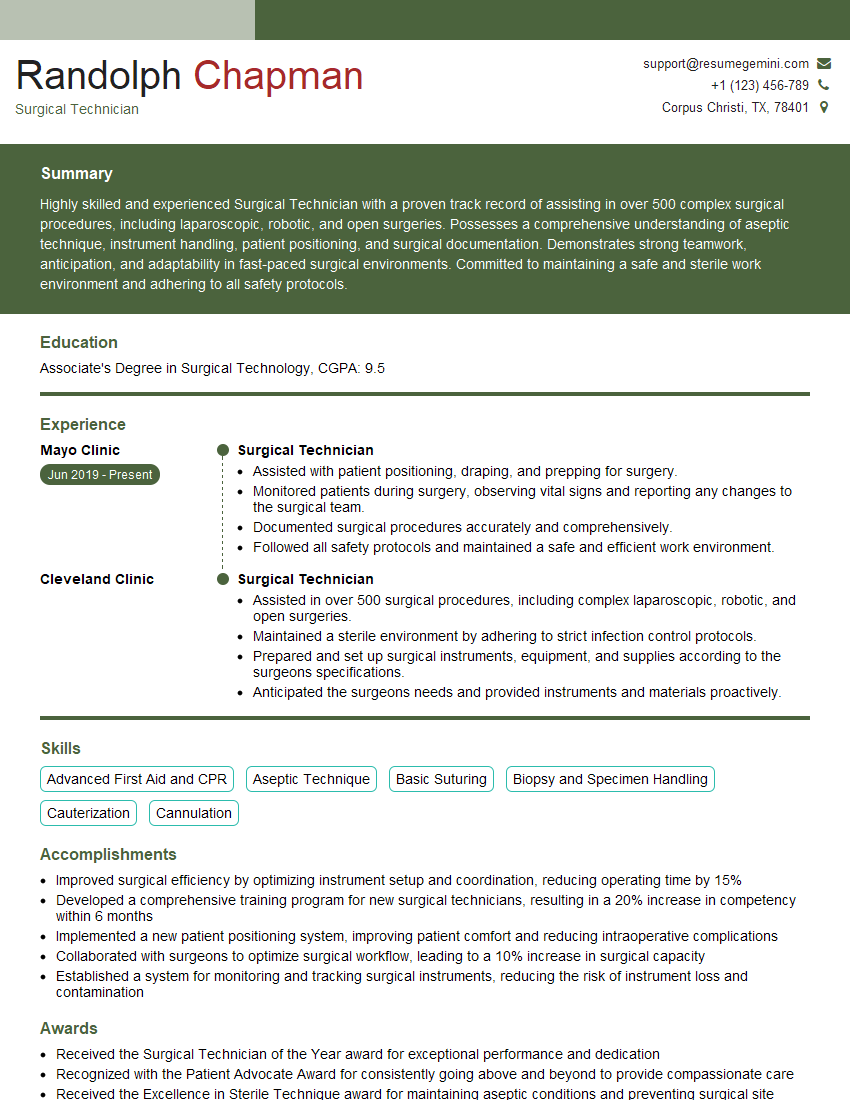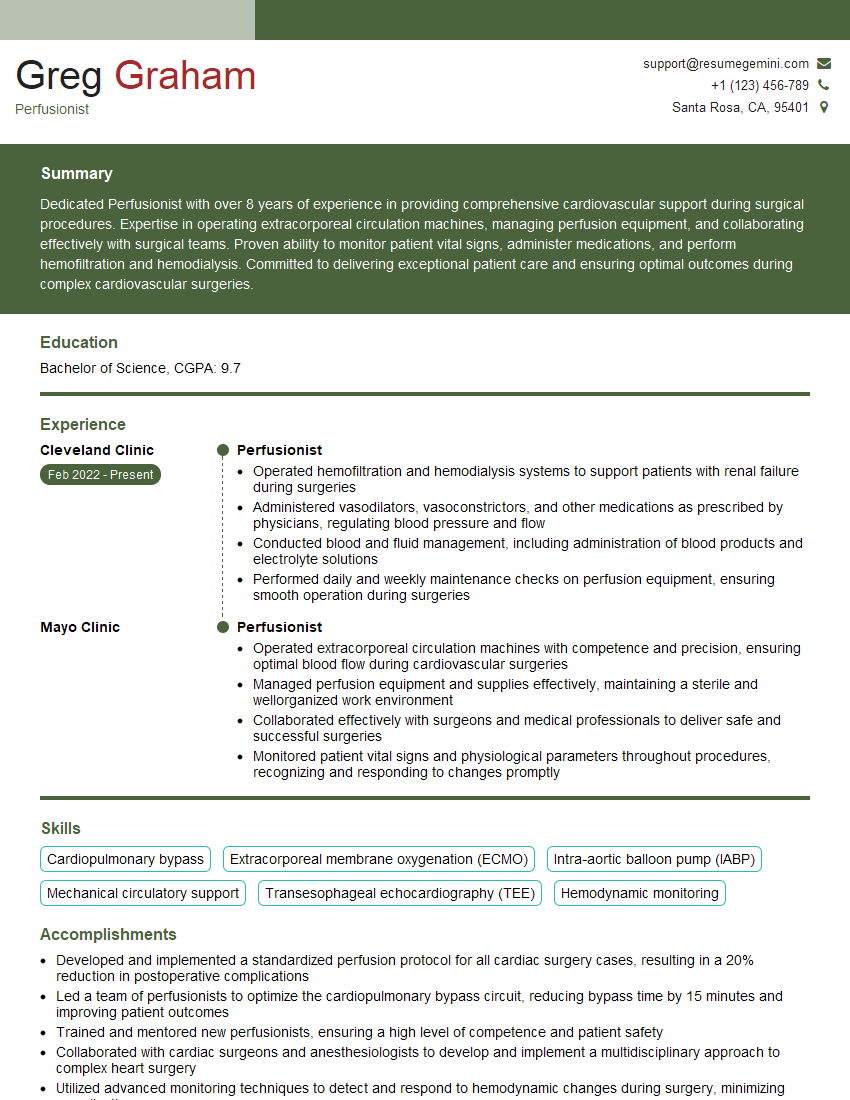Cracking a skill-specific interview, like one for Pericardiocentesis, requires understanding the nuances of the role. In this blog, we present the questions you’re most likely to encounter, along with insights into how to answer them effectively. Let’s ensure you’re ready to make a strong impression.
Questions Asked in Pericardiocentesis Interview
Q 1. Describe the indications for pericardiocentesis.
Pericardiocentesis, the procedure of draining fluid from the pericardial sac, is indicated primarily when a patient presents with cardiac tamponade – a life-threatening condition where fluid accumulation compresses the heart, impairing its ability to pump effectively. Symptoms include hypotension, muffled heart sounds, jugular venous distension (JVD), and pulsus paradoxus (an exaggerated decrease in systolic blood pressure during inspiration). Other indications include diagnostic evaluation of pericardial effusion (fluid build-up) when the cause is uncertain, to relieve significant respiratory compromise due to a large effusion, and to remove blood following cardiac surgery or trauma.
In essence, we perform pericardiocentesis when the fluid in the pericardial sac poses a significant threat to the patient’s hemodynamic stability or respiratory function.
Q 2. Outline the contraindications for pericardiocentesis.
Contraindications to pericardiocentesis are situations where the risks outweigh the benefits. Absolute contraindications include situations where there’s no clear evidence of pericardial effusion or when the effusion is not causing hemodynamic instability. Relative contraindications include the presence of an overlying infection at the puncture site, coagulopathy (problems with blood clotting), and patient inability to cooperate. In a patient with a known bleeding disorder, the risk of significant bleeding during the procedure is a major concern, thus making it a relative contraindication. The experienced physician would carefully weigh these risks against the potential benefits before proceeding.
Q 3. Explain the different approaches for pericardiocentesis (subxiphoid, apical, etc.).
Several approaches exist for pericardiocentesis, each with its own advantages and disadvantages. The subxiphoid approach involves inserting the needle through the xiphoid process (the lower end of the sternum). The apical approach is performed using a needle inserted through the left fifth intercostal space at the mid-clavicular line. The parasternal approach uses the needle inserted through the fourth or fifth left intercostal space close to the sternum. Finally, a subcostal approach uses a needle inserted through the left subcostal area. The choice of approach depends on the operator’s experience, the patient’s anatomy, and the amount and location of pericardial effusion.
Q 4. What are the advantages and disadvantages of each approach?
The subxiphoid approach is relatively easy to perform, but it has a higher risk of liver puncture. The apical approach avoids liver puncture but carries a risk of lung injury. The parasternal approach provides good visualization but has a higher risk of coronary artery injury. The subcostal approach minimizes lung injury but might miss the effusion. The selection of the approach is a critical decision balancing the risk and benefit for each specific patient. The operator’s expertise and familiarity with the various approaches significantly influence the outcome.
Q 5. Describe the necessary equipment and supplies for pericardiocentesis.
Essential equipment includes sterile gloves, drapes, antiseptic solution, local anesthetic (e.g., lidocaine), a 18-20 gauge needle, a syringe (at least 50ml capacity), a catheter for drainage if necessary, a three-way stopcock, a pressure transducer for measuring pressure within the pericardial space, ECG monitoring equipment, and ultrasound equipment (to aid in needle guidance).
Additional supplies should include emergency equipment – oxygen, resuscitation equipment, and blood products – should complications arise. Proper preparation and anticipation of possible challenges are key to a successful and safe procedure.
Q 6. How do you ensure proper patient positioning for pericardiocentesis?
Patient positioning is crucial for successful pericardiocentesis. For the subxiphoid approach, the patient is typically positioned supine with the head of the bed slightly elevated (around 30 degrees). For apical and parasternal approaches, the patient might be positioned in a semi-recumbent or lateral decubitus position (lying on their side) to optimize needle insertion and visualization. The key is to ensure optimal access to the puncture site while minimizing the risk of injury to adjacent organs. Ultrasound guidance greatly assists in accurate patient positioning and needle placement regardless of the chosen approach.
Q 7. Explain the steps involved in performing a pericardiocentesis.
The procedure involves several steps: (1) obtaining informed consent and reviewing the patient’s history and coagulation studies; (2) preparing the patient and the site with sterile technique; (3) administering local anesthetic; (4) using ultrasound or fluoroscopy guidance to accurately locate the needle insertion point and pericardial space; (5) carefully inserting the needle into the pericardial sac while continuously monitoring ECG for signs of arrhythmias; (6) removing the fluid slowly; (7) analyzing the fluid for characteristics like color and cell count; (8) closing the puncture site and observing the patient for complications.
Remember: Close monitoring of the patient’s vital signs and ECG throughout the procedure is critical to ensure safety and identify any immediate complications. It’s vital to emphasize that pericardiocentesis is a procedure performed by trained physicians in a controlled setting, emphasizing the importance of maintaining sterility and monitoring the patient’s vital signs.
Q 8. How do you monitor the patient during and after the procedure?
Monitoring during and after pericardiocentesis is crucial for patient safety. During the procedure, continuous electrocardiogram (ECG) monitoring is essential to detect any arrhythmias, which can be triggered by manipulation of the heart. Blood pressure and heart rate are also closely monitored to assess hemodynamic stability. Oxygen saturation is tracked to ensure adequate oxygenation. The patient’s level of consciousness and pain are assessed regularly. Post-procedure, monitoring continues for at least 4-6 hours, focusing on the same vital signs. We also closely observe the puncture site for bleeding or hematoma formation. Chest X-ray is typically performed to rule out pneumothorax (collapsed lung) or other complications. We look for signs of recurrent tamponade, such as hypotension or muffled heart sounds. Regular blood tests might also be performed to monitor for changes in hemoglobin or other blood parameters indicating bleeding.
Imagine it like this: We’re constantly checking the patient’s ‘dashboard’ – ECG, blood pressure, heart rate, oxygen levels, and pain levels – to ensure everything is running smoothly. Any blip on that dashboard triggers immediate attention.
Q 9. Describe the techniques used to identify the pericardial space.
Identifying the pericardial space accurately is critical to avoid complications. We use a combination of techniques. The most common is using echocardiography (ultrasound of the heart), which allows real-time visualization of the pericardial effusion (fluid accumulation) and guides needle placement. This is like using a GPS to navigate to the precise location of the fluid. In some cases, fluoroscopy (X-ray imaging) may be used, particularly if echocardiography is inconclusive. Anatomical landmarks, such as the xiphoid process (the bony tip of the sternum), can also be used, but these are less reliable on their own. A subxiphoid approach is frequently utilized, entering just below the xiphoid. Alternatively, a parasternal approach may be used, entering through the intercostal space adjacent to the sternum. The choice depends on the location and size of the effusion as well as the clinician’s experience and the availability of imaging guidance.
Q 10. What are the potential complications of pericardiocentesis?
Pericardiocentesis, while life-saving in many cases, carries potential complications. These include:
- Cardiac perforation: Puncturing the heart muscle is a serious risk, leading to bleeding and potentially fatal arrhythmias.
- Pneumothorax: Collapsing a lung by puncturing the pleura is a significant risk.
- Bleeding: Bleeding at the puncture site or into the pericardial space can occur.
- Infection: Infection at the puncture site is a possibility.
- Arrhythmias: Heart rhythm disturbances can be induced by the procedure.
- Recurrent pericardial effusion: The fluid may reaccumulate after drainage.
It’s essential to understand these risks and take all necessary precautions to minimize them. Think of it like a delicate surgery; precise technique and meticulous monitoring are key.
Q 11. How do you manage potential complications like bleeding or pneumothorax?
Management of complications requires prompt action. Bleeding at the puncture site is usually managed with pressure dressing. Significant bleeding or hematoma formation might require surgical intervention. Pneumothorax, if detected by chest X-ray, might require chest tube insertion to allow the lung to re-expand. Cardiac tamponade, if it recurs, may necessitate repeat pericardiocentesis or surgical intervention. Arrhythmias are managed with appropriate medication and close monitoring. Infection is treated with antibiotics. The treatment strategy is highly dependent on the severity and type of complication; early detection and prompt management is critical.
Q 12. What are the post-procedure instructions for the patient?
Post-procedure instructions are critical for a successful outcome. Patients are usually monitored for several hours before discharge. They are advised to rest and avoid strenuous activity for at least 24-48 hours. The puncture site is monitored for any signs of bleeding, swelling, or infection. Patients are instructed to contact their physician immediately if they experience any chest pain, shortness of breath, or fever. Regular follow-up appointments are scheduled to monitor for recurrence of the effusion and assess overall recovery. The post-procedure care is like the aftercare for a minor surgery, requiring rest and close monitoring.
Q 13. How do you interpret the fluid obtained during pericardiocentesis?
Interpreting the fluid obtained during pericardiocentesis involves a multi-step process. The volume of fluid is noted. The fluid is then analyzed for its appearance (e.g., serous, hemorrhagic, purulent), cell count (including white blood cell count and differential), and biochemical parameters (e.g., glucose, protein, lactate dehydrogenase). Microscopic examination may reveal the presence of microorganisms or malignant cells. Cytological and microbiological examination helps confirm the underlying cause of the effusion and guide further management. For instance, a purulent effusion would strongly suggest infection, while a hemorrhagic effusion could indicate trauma or malignancy.
Q 14. What are the different types of pericardial fluid, and their significance?
Pericardial fluid can be classified into different types based on its appearance and composition, each with clinical significance:
- Serous effusion: This is a clear, straw-colored fluid, often seen in heart failure or other non-inflammatory conditions.
- Hemorrhagic effusion: This is a bloody effusion, which can be caused by trauma, malignancy, or anticoagulation therapy.
- Purulent effusion: This is a cloudy, pus-like fluid, indicative of infection (purulent pericarditis).
- Chylous effusion: This milky white fluid occurs due to leakage of lymphatic fluid into the pericardium.
The type of fluid obtained is an important clue in identifying the underlying etiology of pericardial effusion. It guides the choice of treatment and dictates the prognosis.
Q 15. Describe the role of echocardiography in pericardiocentesis.
Echocardiography plays a crucial role in pericardiocentesis, acting as the eyes and ears of the procedure. Before we even consider inserting a needle, we use echocardiography to confirm the presence of pericardial effusion (fluid around the heart), assess its size and location, and identify the optimal puncture site to avoid major vessels. Real-time imaging allows us to visualize the needle’s approach and its proximity to vital structures, minimizing the risk of complications. For example, we can see if the fluid is loculated (confined to a specific area) or free-flowing, influencing our needle placement strategy. We also use it to evaluate the heart’s function during and after the procedure, ensuring that we’re not causing further harm.
Think of it like this: trying to drain fluid from the pericardial sac without echocardiography is like trying to navigate a maze blindfolded. Echocardiography illuminates the path, allowing for a safe and precise procedure.
Career Expert Tips:
- Ace those interviews! Prepare effectively by reviewing the Top 50 Most Common Interview Questions on ResumeGemini.
- Navigate your job search with confidence! Explore a wide range of Career Tips on ResumeGemini. Learn about common challenges and recommendations to overcome them.
- Craft the perfect resume! Master the Art of Resume Writing with ResumeGemini’s guide. Showcase your unique qualifications and achievements effectively.
- Don’t miss out on holiday savings! Build your dream resume with ResumeGemini’s ATS optimized templates.
Q 16. How do you determine the appropriate needle size and length for pericardiocentesis?
The choice of needle size and length for pericardiocentesis depends on several factors, primarily the patient’s body habitus (size and build) and the location of the effusion as determined by echocardiography. We typically use a relatively small-gauge needle (18-22 gauge) to minimize trauma. Longer needles (10-15cm) might be necessary for obese patients or deep effusions, but we strive to use the shortest needle possible to reduce the risk of puncturing the heart or lungs. The goal is a balance: adequate length to reach the effusion while minimizing potential complications.
For instance, a thinner patient with a superficial effusion might require an 18-gauge, 10cm needle, while a larger patient with a deep effusion may need a 20-gauge, 15cm needle. The choice is always individualized, based on a careful assessment of the patient and the echocardiographic findings.
Q 17. What are the alternative methods to pericardiocentesis for cardiac tamponade?
While pericardiocentesis is the most common procedure for treating cardiac tamponade (life-threatening compression of the heart due to fluid), alternative approaches exist, each with its own set of advantages and disadvantages. Surgical pericardiotomy, a surgical incision to drain the fluid, is often reserved for cases where pericardiocentesis fails, or in situations with recurrent or extremely large effusions. Pericardial window creation, a minimally invasive surgical procedure, creates a permanent opening to allow fluid drainage, which is useful for patients with recurrent effusions. Finally, in emergency situations where immediate intervention is critical and pericardiocentesis is not immediately feasible, supportive measures such as intravenous fluid resuscitation and inotropic support (medications that improve heart muscle contraction) may be employed to stabilize the patient before definitive treatment.
Q 18. How do you calculate the amount of fluid removed during pericardiocentesis?
The amount of fluid removed during pericardiocentesis isn’t calculated in a precise mathematical sense; it’s a clinical judgment based on the patient’s hemodynamic status (blood pressure, heart rate). We monitor vital signs closely throughout the procedure. Generally, we aim to remove enough fluid to relieve the cardiac tamponade, which typically translates to a significant improvement in blood pressure and a reduction in the size of the pericardial effusion on echocardiography. Removing too much fluid too quickly can lead to re-expansion pulmonary edema (fluid in the lungs), while leaving too much fluid behind will not sufficiently alleviate the cardiac compromise. The goal is to achieve hemodynamic stability without precipitating complications.
We use a graduated collection container for measuring the amount drained. The actual volume isn’t a rigid number; rather, the key is the clinical response.
Q 19. What is the role of a local anesthetic in pericardiocentesis?
Local anesthesia is crucial in pericardiocentesis for patient comfort and to facilitate a smooth procedure. A subcutaneous injection of lidocaine around the puncture site numbs the skin and underlying tissues, minimizing discomfort during needle insertion. This not only enhances the patient’s experience but also prevents unnecessary movement which could compromise the procedure’s precision. The use of local anesthetic allows for a more controlled and less stressful experience for the patient, improving their tolerance of the procedure. It is a critical element of minimizing patient anxiety and ensuring a safe environment.
Q 20. What are the criteria for successful pericardiocentesis?
Successful pericardiocentesis is defined by several criteria: first and foremost is the relief of symptoms related to the cardiac tamponade, such as hypotension (low blood pressure) and tachycardia (rapid heart rate). Secondly, echocardiography should confirm a significant reduction in the size of the pericardial effusion. Thirdly, the procedure should be completed without major complications like pneumothorax (collapsed lung), vascular injury, or cardiac perforation. Finally, the patient should remain hemodynamically stable post-procedure. It’s a multi-faceted definition; simply removing fluid is not enough; it’s the positive effect of that fluid removal on the patient’s physiological state that truly determines success.
Q 21. Describe your experience with performing pericardiocentesis.
I have extensive experience performing pericardiocentesis, having performed hundreds of procedures over my career. I’ve managed a wide range of cases, from straightforward effusions to those presenting with complex anatomical challenges. Early in my career, I benefited immensely from working with experienced colleagues and observing their techniques. The integration of echocardiography has been a game changer; it allows for incredibly precise needle placement, which has undoubtedly decreased the rate of complications in my practice. One case that stands out was a patient with a large, loculated effusion that was particularly difficult to access. By using a combination of subcostal and parasternal approaches guided by real-time echocardiography, we successfully drained the effusion and stabilized the patient. This experience underscores the value of meticulous planning, attention to detail and appropriate application of the available technology.
Q 22. Discuss a case where you had a complication during pericardiocentesis and how you managed it.
During my years of practice, I encountered a complication during a pericardiocentesis procedure involving accidental puncture of the left ventricle. The patient, a 65-year-old male presenting with acute cardiac tamponade, was undergoing an urgent procedure. While attempting the procedure using ultrasound guidance, the needle inadvertently penetrated the ventricular wall. This resulted in a brief period of brisk bleeding into the pericardial sac, immediately noticeable by a change in the aspirated fluid from serosanguinous to frank blood.
My immediate response involved ceasing aspiration, immediately withdrawing the needle, and applying firm pressure to the puncture site. Simultaneously, we initiated advanced cardiac life support (ACLS) protocols, including administering intravenous fluids and oxygen, and preparing for potential surgical intervention. The patient’s hemodynamic status was closely monitored, with continuous ECG and pulse oximetry. We performed a repeat echocardiogram to assess the extent of the ventricular injury and the residual pericardial effusion. Fortunately, the bleeding was self-limiting. We then successfully repeated the pericardiocentesis, this time using a more cautious approach and altered needle insertion angle, and ultimately achieved successful drainage of the pericardial effusion, stabilizing the patient’s condition. The patient received close observation for the next 24 hours and was subsequently discharged without further complications.
This experience underscored the critical importance of meticulous attention to detail during the procedure, the absolute necessity of real-time echocardiographic guidance, and the importance of a readily available backup plan for managing complications.
Q 23. How do you assess the patient’s hemodynamic status before and after pericardiocentesis?
Assessing a patient’s hemodynamic status before and after pericardiocentesis is crucial for determining the effectiveness of the procedure and identifying potential complications. Pre-procedure assessment involves a comprehensive evaluation, including:
- Vital signs: Blood pressure, heart rate, respiratory rate, and oxygen saturation. Hypotension, tachycardia, and tachypnea are indicative of cardiac tamponade.
- Physical examination: Assessing for jugular venous distension (JVD), muffled heart sounds (Beck’s triad – along with hypotension and JVD), and pulsus paradoxus.
- Electrocardiogram (ECG): Looking for electrical alternans (variation in amplitude of QRS complexes) and low voltage QRS complexes which suggest pericardial effusion.
- Echocardiography: This is essential for confirming the diagnosis of pericardial effusion, determining its size, and evaluating the impact on cardiac function.
Post-procedure assessment involves repeating these measurements to assess for improvement. For instance, we expect to see an increase in blood pressure, a decrease in heart rate, and a reduction in JVD. The echocardiogram will show a decreased amount of pericardial fluid. Any deterioration in vital signs warrants immediate attention, potentially requiring further intervention.
Q 24. What are the long-term implications of pericardiocentesis?
The long-term implications of pericardiocentesis are generally minimal for uncomplicated cases. However, potential long-term complications can occur, albeit rarely. These include:
- Recurrence of pericardial effusion: This requires further investigation into the underlying cause.
- Pericarditis: Inflammation of the pericardium can occur as a post-procedural complication.
- Cardiac tamponade (rare): If the underlying cause is not addressed, this life-threatening condition may recur.
- Infection: Although infrequent with aseptic technique, infection at the puncture site is a possibility.
- Bleeding: As in the case I described previously, though uncommon, significant hemorrhage can result from accidental puncture of the heart.
The majority of patients who undergo uncomplicated pericardiocentesis experience complete resolution of their symptoms and return to normal activity without long-term issues. Regular follow-up is recommended to monitor for any potential complications and ensure patient wellbeing.
Q 25. What are the ethical considerations involved in performing pericardiocentesis?
Ethical considerations in performing pericardiocentesis center around obtaining informed consent, ensuring patient autonomy, and minimizing risks.
- Informed Consent: Patients must understand the procedure, its benefits, risks (including potential complications like bleeding and cardiac injury), and alternatives before consenting. This requires clear, concise, and accessible communication tailored to the patient’s understanding.
- Beneficence and Non-Maleficence: The procedure should only be performed when the potential benefits outweigh the risks. Careful assessment and selection of patients are essential.
- Justice: Equitable access to the procedure should be ensured, regardless of socioeconomic status or other factors.
- Competence: The procedure should only be performed by qualified and experienced professionals.
In emergency situations where immediate intervention is critical to save a patient’s life, obtaining fully informed consent may not be feasible. In such cases, implied consent is invoked – acting in the patient’s best interest given their immediate life-threatening condition.
Q 26. How do you document the pericardiocentesis procedure?
Meticulous documentation of the pericardiocentesis procedure is essential for medical-legal reasons and to facilitate patient care. The documentation should include:
- Patient identification: Full name, date of birth, medical record number.
- Indications for the procedure: Detailed clinical presentation, including symptoms, signs, and diagnostic findings such as ECG and echocardiogram results.
- Pre-procedure assessment: Vital signs, physical examination findings, and hemodynamic status.
- Procedure details: Date, time, location, type of needle and catheter used, approach used (subxiphoid, apical, etc.), amount of fluid aspirated, and fluid characteristics (color, clarity). Ultrasound guidance details, if used.
- Post-procedure assessment: Vital signs, ECG, and echocardiography findings, and any complications encountered.
- Fluid analysis: Laboratory results of aspirated fluid.
- Post-procedure management: Medications administered and subsequent monitoring.
- Physician signature and credentials.
Clear and concise documentation minimizes potential misunderstandings and ensures the continuity of patient care.
Q 27. What are the relevant anatomy considerations during pericardiocentesis?
Anatomical considerations are paramount to safe and effective pericardiocentesis. The procedure necessitates a thorough understanding of the structures surrounding the pericardium.
- Cardiac anatomy: The relationship of the heart to the surrounding structures including the diaphragm, lungs, and great vessels.
- Pericardial space: Knowledge of its location, size, and the optimal approach for needle insertion.
- Vascular structures: Awareness of the proximity of major blood vessels, including the aorta, pulmonary artery, and coronary arteries, and how to minimize the risk of accidental puncture.
- Liver and diaphragm: Consideration of the liver and diaphragm position, particularly during subxiphoid approaches.
Anatomical variations, particularly in obese patients, can affect the procedure’s feasibility and safety. This necessitates thorough planning and a cautious approach, especially when relying on anatomical landmarks without ultrasound guidance.
Q 28. Explain the concept of blind versus ultrasound-guided pericardiocentesis.
Pericardiocentesis can be performed using two main techniques: blind and ultrasound-guided.
Blind Pericardiocentesis: This technique relies on anatomical landmarks to guide needle placement. It’s typically performed using a subxiphoid approach. While historically used, it’s associated with a higher risk of complications due to the reliance on anatomical estimation and lack of real-time visualization. This is largely considered outdated now unless in extreme emergencies with limited resources.
Ultrasound-Guided Pericardiocentesis: This technique uses real-time ultrasound imaging to visualize the heart, pericardium, and needle during the procedure. This significantly reduces the risk of complications by allowing for precise needle placement and immediate detection of potential problems such as accidental puncture of the heart or lung. It is the preferred technique in most cases because of its increased safety and accuracy. The use of ultrasound further guides us in choosing the best approach (subxiphoid, parasternal, apical, etc.) for each patient based on the individual anatomy and the location of the effusion.
In summary, while blind pericardiocentesis may be necessary in extremely limited settings, ultrasound guidance is strongly recommended for its enhanced safety and efficacy. The minimally invasive nature, improved success rate, and lower complication rate make ultrasound-guided pericardiocentesis the gold standard.
Key Topics to Learn for Pericardiocentesis Interview
- Anatomy and Physiology: Thorough understanding of the pericardial sac, its layers, and surrounding structures. Include knowledge of normal and abnormal pericardial fluid dynamics.
- Indications and Contraindications: Master the criteria for performing pericardiocentesis, including recognizing situations where it’s necessary and when it’s contraindicated.
- Procedure Technique: Detailed knowledge of the different approaches (subxiphoid, apical, etc.), including equipment, positioning, and step-by-step execution. Practice visualizing the procedure mentally.
- Complications and Management: Anticipate potential complications (e.g., cardiac perforation, pneumothorax, bleeding) and understand the immediate management strategies for each.
- Pre- and Post-Procedure Care: Understand the essential elements of patient preparation, monitoring during and after the procedure, and post-procedure care instructions.
- Diagnostic and Therapeutic Applications: Distinguish between performing pericardiocentesis for diagnostic purposes (fluid analysis) and therapeutic purposes (fluid drainage).
- Imaging Guidance: Understand the role of echocardiography and fluoroscopy in guiding the procedure and improving safety.
- Case Studies and Problem-Solving: Analyze various scenarios and practice identifying and resolving potential challenges encountered during the procedure.
- Ethical Considerations: Be prepared to discuss informed consent, patient safety, and the ethical implications of this procedure.
Next Steps
Mastering Pericardiocentesis demonstrates advanced clinical skills and significantly enhances your competitiveness in the job market. To secure your dream role, a well-crafted resume is essential. Creating an ATS-friendly resume increases your chances of getting noticed by recruiters. We highly recommend using ResumeGemini, a trusted resource for building professional and effective resumes. ResumeGemini provides examples of resumes tailored to Pericardiocentesis, ensuring your application stands out. Take the next step in your career journey – build a compelling resume that highlights your Pericardiocentesis expertise.
Explore more articles
Users Rating of Our Blogs
Share Your Experience
We value your feedback! Please rate our content and share your thoughts (optional).
What Readers Say About Our Blog
Hello,
We found issues with your domain’s email setup that may be sending your messages to spam or blocking them completely. InboxShield Mini shows you how to fix it in minutes — no tech skills required.
Scan your domain now for details: https://inboxshield-mini.com/
— Adam @ InboxShield Mini
Reply STOP to unsubscribe
Hi, are you owner of interviewgemini.com? What if I told you I could help you find extra time in your schedule, reconnect with leads you didn’t even realize you missed, and bring in more “I want to work with you” conversations, without increasing your ad spend or hiring a full-time employee?
All with a flexible, budget-friendly service that could easily pay for itself. Sounds good?
Would it be nice to jump on a quick 10-minute call so I can show you exactly how we make this work?
Best,
Hapei
Marketing Director
Hey, I know you’re the owner of interviewgemini.com. I’ll be quick.
Fundraising for your business is tough and time-consuming. We make it easier by guaranteeing two private investor meetings each month, for six months. No demos, no pitch events – just direct introductions to active investors matched to your startup.
If youR17;re raising, this could help you build real momentum. Want me to send more info?
Hi, I represent an SEO company that specialises in getting you AI citations and higher rankings on Google. I’d like to offer you a 100% free SEO audit for your website. Would you be interested?
Hi, I represent an SEO company that specialises in getting you AI citations and higher rankings on Google. I’d like to offer you a 100% free SEO audit for your website. Would you be interested?
good
